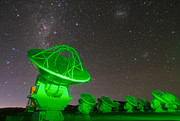Zprávy
ALMA Doubles its Power in New Phase of More Advanced Observations
Green light for ALMA Early Science Cycle 1
8. ledna 2013
ALMA (the Atacama Large Millimeter/submillimeter Array) has begun a new and more advanced phase of science observations. This phase is known as Early Science Cycle 1, and will last until October 2013. The telescope’s power has been greatly increased: it will make observations with more antennas, spread over a greater distance, than ever before, and will use antennas from the Atacama Compact Array (ACA) for the first time.
Although ALMA is still under construction, its first scientific operations began in 2011. This phase was known as Early Science Cycle 0. ALMA has already outperformed all other telescopes of its kind, and the unprecedented capabilities of the telescope have brought a first wave of exciting scientific results over the last year (see for example ann12101, eso1216, eso1239, and eso1248).
The Cycle 0 observations started with just 16 of the telescope’s final complement of 66 antennas (which will be composed of a main array of fifty 12-metre dishes, and a group of twelve 7-metre and four 12-metre dishes that make up the ACA). As an interferometer, ALMA behaves like a telescope as large as the greatest separation between antennas, and in Cycle 0 these antennas were spread over distances of about 400 metres.
In Cycle 1, ALMA will use at least 32 of the 12-metre antennas in the main array, double the 16 specified for Cycle 0, increasing both its light-collecting power and image quality. The antennas will be spread over greater distances of up to one kilometre, more than doubling the maximum resolution of the telescope. The ALMA correlator — the special-purpose supercomputer which combines the signals from the antennas — is also now fully operational to handle the larger number of antennas (see eso1253). And, for the first time, antennas from the ACA will be available for science observations — at least nine 7-metre antennas, and two 12-metre antennas — for use in combination with the main array when observing extended objects in the sky.
The larger 12-metre antennas of the main array cannot be placed closer than 15 metres apart as they would otherwise bump into each other. This minimum separation between antennas governs the maximum scale of the features that they can detect in the sky. This means that the main array cannot observe the broadest features of extended objects such as giant clouds of molecular gas in the Milky Way, or nearby galaxies. The ACA is specifically designed to help ALMA make better observations of these extended objects. Its smaller 7-metre antennas can be placed closer together, making them better able to measure the broader structures that the main array misses.
It is anticipated that about 800 hours of observing time on the main array, and 800 hours on the ACA, will be available during Cycle 1.
Over 1100 proposals were received for Cycle 1 observations, from astronomers around the world, and just 196 were selected as the highest priority projects. These projects span an extremely broad range of astronomical topics, across the five main ALMA science areas: cosmology and the very distant Universe; galaxies and their nuclei; the interstellar medium, star formation and astrochemistry; exoplanets, discs around stars, and the Solar System; and the evolution of stars and the Sun.
More Information
The ALMA project is a partnership of Europe, North America and East Asia in cooperation with the Republic of Chile. ALMA is funded in Europe by ESO, in North America by the U.S. National Science Foundation (NSF) in cooperation with the National Research Council of Canada (NRC) and the National Science Council of Taiwan (NSC) and in East Asia by the National Institutes of Natural Sciences (NINS) of Japan in cooperation with the Academia Sinica (AS) in Taiwan. ALMA construction and operations are led on behalf of Europe by ESO, on behalf of North America by the National Radio Astronomy Observatory (NRAO), which is managed by Associated Universities, Inc. (AUI) and on behalf of East Asia by the National Astronomical Observatory of Japan (NAOJ). The Joint ALMA Observatory (JAO) provides the unified leadership and management of the construction, commissioning and operation of ALMA.
Odkazy
- More about ALMA at ESO
- ALMA Early Science Cycle 1: Outcome of the Proposal Review Process
- ALMA Early Science Cycle 1: Call for Proposals
- ALMA Science Portal (for astronomers)
- European ALMA Regional Centre website
- North American ALMA Regional Center website
- East Asian ALMA Regional Center website
- Joint ALMA Observatory
Kontakty
Douglas Pierce-Price
Public Information Officer, European Southern Observatory
Garching bei München, Germany
Tel: +49 89 3200 6759
Email: dpiercep@eso.org
Leonardo Testi
European Southern Observatory
Garching, Germany
Tel: +49 89 3200 6541
Email: ltesti@eso.org
O zprávě
| Id: | ann13002 |

